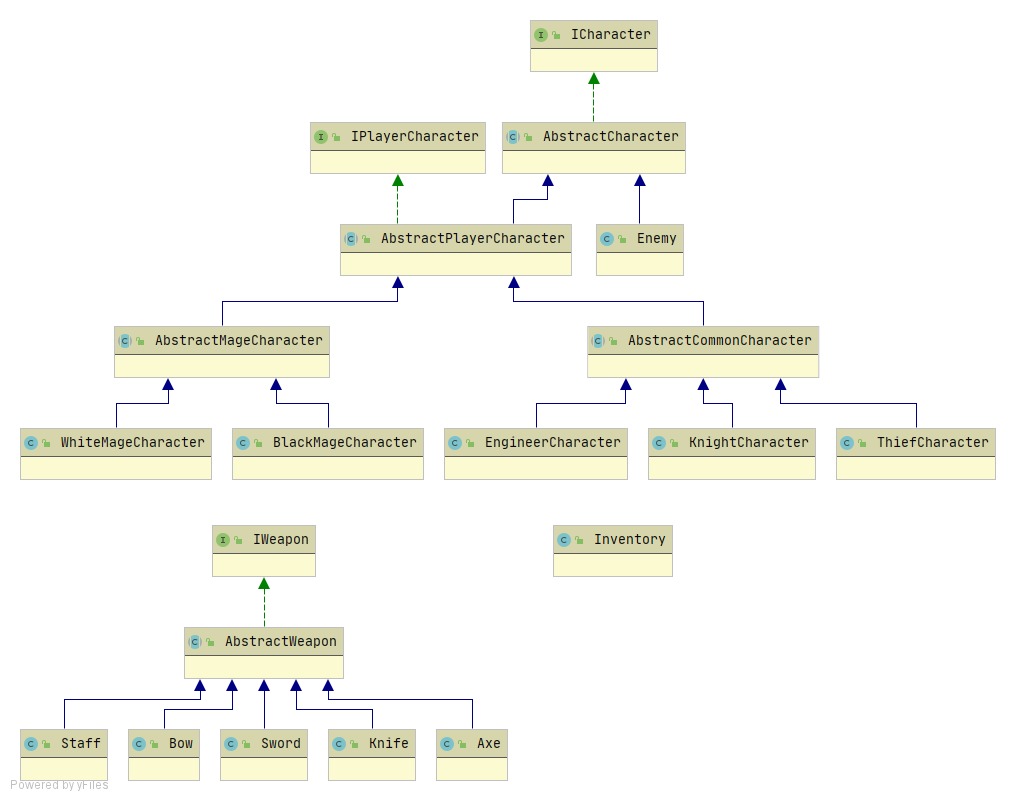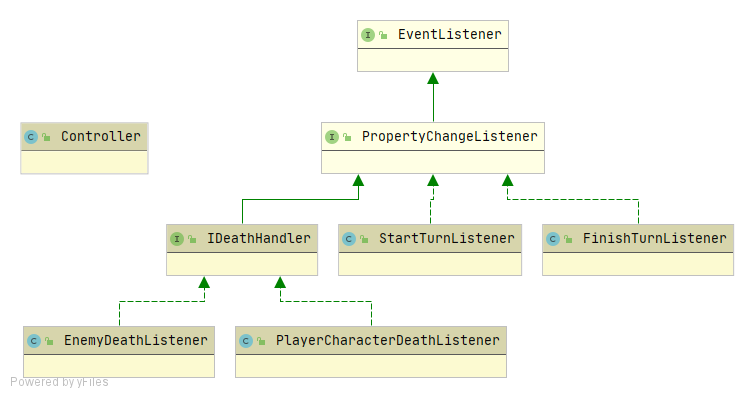This work is licensed under a Creative Commons Attribution 4.0 International License
This project's goal is to create a (simplified) clone of Final Fantasy's combat, a game developed by Square Enix Broadly speaking for the combat the player has a group of characters to control and a group of enemies controlled by the computer.
The first we have is the AbstractCharacter abstract class, here you will find common attributes and methods between enemies and playable characters, like health points, defense, name and methods like getters, setters and receiveDamage(). This class implements the ICharacter interface.
The next class we have is the Enemy class, here you will find a class with the attributes and methods that only an enemy has, like damage, weight, burnDamage, venomDamage.
Then you will find AbstractPlayerCharacter abstract class, this class inherits from AbstractCharacter class some methods and attributes, here you have equip() method, this method uses double dispatch because every player character type (thief, knight, etc) has different weapons to equip. Another new method is commonAttack(), this method targets an enemy and this object attacks with the equipped weapon, doing damage. This class implements the IPlayerCharacter interface
There are two big types of characters, CommonCharacters (like thief, knight and engineer), these characters can't use magic, so they don't have mana or magic attacks, you will find an abstract class named AbstractCommonCharacter, to have the methods that these type of characters will inherit, like the hashCode() method.
The other big type of characters is MageCharacters (like black mage and white mage), these type of characters can use magic and do magic attacks, for this exists the abstract class AbstractMagicCharacters, here you will find mana attribute, methods to set it and get it, all mages will inherit from this class.
For all player character types exists a class:
ThiefCharacter : This class inherits from AbstractCommonCharacter class
KnightCharacter : This class inherits from AbstractCommonCharacter class
EngineerCharacter : This class inherits from AbstractCommonCharacter class
BlackMageCharacter : This class inherits from AbstractMagicCharacter class, here you will find methods for magic attacks like thunder() and fire().
WhiteMageCharacter : This class inherits from AbstractMagicCharacter class, here you will find methods for magic attacks like paralyze(), venom() and cure().
All of these classes are in character package.
The next package is weapon, here you will find an abstract class called AbstractWeapon, with the methods and attributes that all weapons have like weight, damage, name, all attributes have getters. All weapons have a method with a name like equipTo___() where the ____ is a name of a player character class (Example: equipToThief()), this is called when a player character objects calls equip() doing a double dispatch, only if the weapon can be equipped to the class of the player character, the object that called equip() will be equipped with the weapon, else will not. AbstractWapon class implements the ICharacter interface
For all weapon types exists a class:
Axe : This weapon can be equipped to KnightCharacter, EngineerCharacter classes..
Bow : This weapon can be equipped to ThiefCharacter, EngineerCharacter classes.
Knife : This weapon can be equipped to KnightCharacter, BlackMageCharacter classes.
Staff : This weapon can be equipped to ThiefCharacter, BlackMageCharacter, WhiteMageCharacter classes.
Sword : This weapon can be equipped to ThiefCharacter, KnightCharacter classes.
The last package is the inventory, the only class here is Inventory class, with attributes like a list of IWeapons, a pointer to an index of the list and the len of the list. With a object of this class you can storage weapons and access to equip the weapon indexed by the pointer to a character.
- model
- character
- player
- commoncharacter
- magecharacter
- inventory
- weapon
All changes on classes were to keep SOLID principles.
The Controller can make Characters by calling makeType(data) where Type can be a player character type (like Knight, Thief, Engineer, BlackMage, WhiteMage or Enemy) and data depends on the Type, if the type is a common player character, the data needed will be the name, maxHp, defense, if the type is a mage, will be needed the same and maxMana value, if the type is Enemy, will be needed the name, maxHp, weight, defense and damage.
Weapons can be made like the characters, just by calling makeType(data), where the type is a weapon type like Sword, Axe, Bow, Knife and Staff. The data values will be the name of the weapon, the damage and the weight, only Staff will need one more value, the magicDamage.
The characters will be saved in lists, one for player characters and one for enemies, to get a character just use the getPlayerCharacter(i) where the i is the index of the wanted player character, and getEnemy(i) to do the same but using the enemies list. For all character attributes exists methods to get them, there are for Enemy class and for IPlayerCharacter.
The Controller makes an inventory (from Inventory class), to move in there exists methods to move the inventory pointer up, down, left or right; and once you are pointing the weapon you wanted, just call equipWeaponTo(playerCharacter) where playerCharacter is the character who will be equipped with the pointed weapon.
There are methods to attack, one for player characters and one for enemies. Both works similar, calling the method with the first parameter the attacker, and the second parameter is the target of the attack.
The game uses five phases, one is the WaitingPhase, here the game waits looking if the queue adds a character, if happens the game changes to DecisionPhase, here the controller takes a character from the queue an depending of his type changes to EnemyPhase or PlayerPhase.
In the EnemyPhase, the turn is for an enemy, so just does an automatic attack, at PlayerPhase, the game waits for inputs by the user, here the user can equip weapons, select weapons, attack and select target. Both phases ends when a character attacks an alive character, when this happens return to waiting phase looking if there is a character in the queue to start a new turn.
The las phase is EndPhase, this phase will be setted when the game ends, just to stop the game.
A turn finishes when a character attacks, this activates the observer and turns to waiting phase. When a new character enters to the queue, activates the newTurn() method and depending on the actual phase, starts a new turn (this happens when the actual phase is WaitingPhase).
When a turn starts, the phase changes to DecisionPhase, here if the character that uses the turn is an Enemy, the character does an automatic attack, if the character was a PlayerCharacter, the game waits for the user decisions.
The user wins when all enemies die, and loses when all player characters dies. To implement this, the Controller uses two listeners, one is for the enemies and the other for player characters, the listeners uses their method when a character calls fainted() method, then reduce by one the count of their type of character. If the count of player characters become 0, the user loses, if the count of enemies become 0, the user wins.
- controller / listeners
- phases
- Main View:
-
There are three counters, the players counter increase when a player character is added, the enemies counter increase when you add an enemy, the weapons counter increase when a weapon is added. The game requires at least one of each, and you can't exceed 4 players, 8 enemies and 12 weapons.
-
There are five inputs, to make a player you need to fill name, maxHp and defense. To make an enemy you need to fill name, maxHp, defense, damage and weight. To make a weapon you nedd to fill name, damage and weight.
-
Starts a new game, making a default set up of characters, enemies and weapons.
-
Starts a game with the added player characters, enemies and weapons.
-
Makes a player character using the inputs from 2.
-
Makes an enemy using the inputs from 2.
-
Makes a weapon using the inputs from 2.
- BattleView (waiting for turn)
-
Player character images.
-
Info about player characters (name, hp, def and weight).
-
Inventory.
-
Actual pointed weapon.
-
Game buttons.
-
Info about weapons (name, damage, weight).
-
Weapon image.
- BattleView (player's turn)
-
Actual player character.
-
Actual pointed weapon
-
Buttons to point the previous enemy or the next.
-
Mark to the actual pointed enemy.
-
Button to attack the actual pointed enemy using the actual player character.
-
Buttons to move the inventory pointer and equip the actual pointed weapon to the actual player character.
Execute FinalReality.java to play the game. When the game starts you will see the main view, here you can choose if you want to just play by clicking Play with default configurations. this button makes default characters and starts a game. If you want to make your own game, you have to make at least one player character, one enemy and one weapon, there you have three counters to know how many objects you create, the max quantity of player characters is 4, of enemies 8 and weapons 12, finally to start the game click on start button.
All games starts with player characters using a toy weapon, this weapon has the value 20 for weight and 0 for damage so you will need one weapon to do damage.
When the game starts the view changes to a battle scene, with your player characters at left and enemies at right, weapons are in the bottom, here you will see all the information about characters and weapons, to play just wait for your turn, when a player character has an arrow at the left, is your turn and you are using the character with the arrow.
From this phase you can equip weapons to the actual character using the buttons, using the Attack button will make the actual player attacks the enemy with red aura if you want to attack other enemy use the buttons to point another. The phase will ends when the actual character does an attack to a alive enemy.
The enemies turns are automatic, when the game finishes you will see if you won or lose. Good Luck.
- Inventory will be used like a list of weapons.
- If the victim's defense is more than the damage that it receives, the victim will only not receive damage.
- Win, nextTurn and lose methods will be implemented the next iteration.
- A turn finishes when a character attacks, and the next turn starts if there is at least one character in the turnsQueue and there is not another character using the turn.
- All players starts with a toy weapon (weapon with 0 damage and 20 weight). . The game needs at least one enemy, one player character and one weapon to start.













